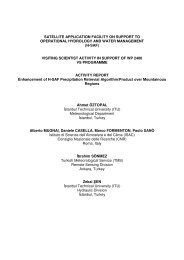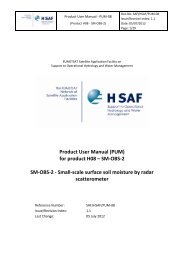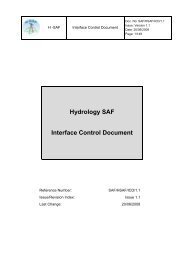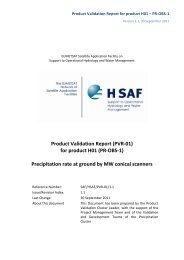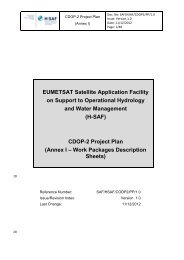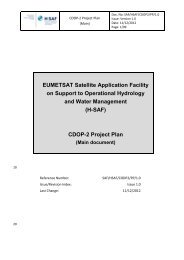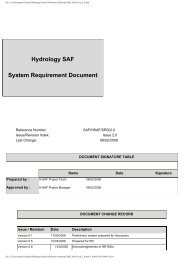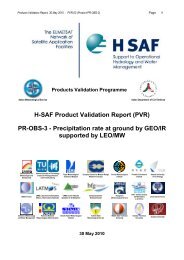(H-SAF) PROJECT PLAN - Version 2
(H-SAF) PROJECT PLAN - Version 2
(H-SAF) PROJECT PLAN - Version 2
You also want an ePaper? Increase the reach of your titles
YUMPU automatically turns print PDFs into web optimized ePapers that Google loves.
H-<strong>SAF</strong> Project Plan 2.0, October 2007 - Update PP-2.2, 10 April 2008 - Chapter 2 (From the Development Proposal) Page 20<br />
TKK/LST has an important role in the international snow research community. The laboratory's<br />
research includes modelling of radiometer observations of snow covered terrain as well as development<br />
of applications including the retrieval of SWE and Snow Depth from radiometer and radar data.<br />
The Finish activity in H-<strong>SAF</strong> covers:<br />
• coordination of Cluster-3 (Snow parameters);<br />
• development of algorithms and software for snow products on flat areas and forests;<br />
• generation of snow products on flat areas and forests;<br />
• snow products calibration, and contribution to validation;<br />
• education and training on the use of satellite-derived snow products in Hydrology.<br />
France<br />
Météo France, specifically the Department of Operational Hydro-meteorology (DP/DCLIM/HYDRO).<br />
DP/DCLIM/HYDRO is in charge of operational hydro-meteorology at Météo-France, and represents<br />
France in the Commission for Hydrology of the World Meteorological Organization (WMO/CHy). It is<br />
responsible, i.a., of the national rainfall database.<br />
The Centre d’études des Environnements Terrestres et Planétaires (CETP), belonging to CNRS<br />
(Centre Nationale de la Recherche Scientifique), will participate in association with the University of<br />
Versailles-St Quentin (UVSQ). The CETP team has two main research activities:<br />
• the use of multi-frequency satellite remote sensing data to infer soil and vegetation parameters,<br />
• the assimilation of satellite remote sensed surface variables (surface temperature and/or soil<br />
moisture) in hydrological and surface models.<br />
The Centre d'Etudes Spatiales de la BIOsphere (CESBIO), also belongs to CNRS. CESBIO aims at<br />
developing knowledge on continental biosphere dynamics and functioning at various temporal and<br />
spatial scales. This includes its interactions with atmosphere and anthropic impact on water resources<br />
and land use. CESBIO leads the European space mission SMOS (Soil Moisture and Ocean Salinity).<br />
The French activity in H-<strong>SAF</strong> covers:<br />
• contribution of CETP to validation of soil moisture products;<br />
• contribution of CESBIO to the development of soil moisture products;<br />
• participation of Météo France to the Hydrological validation programme.<br />
Germany<br />
The Federal Institute of Hydrology (Bundesanstalt für Gewässerkunde, BfG), founded in 1948 but<br />
with precursors in Germany since 1851, has wide expertise in hydrological modelling, possible use of<br />
satellite products for that purpose and the usage of meteorological data and forecasts from the German<br />
Weather Service (Deutscher Wetterdienst, DWD). It has near-real time access to operational data of:<br />
• hydrological in-situ networks (hourly or shorter intervals);<br />
• weather forecasts of DWD (mainly precipitation and air temperature, hourly, 72 h ahead for the nonhydrostatic<br />
Local Model / LM and 3-hourly, 7 d ahead for the Global Model - Europe / GME);<br />
• in-situ and calibrated weather radar precipitation data (1 km², hourly, operational from 2005 on)<br />
provided by DWD;<br />
• snow parameters and forecasts of snow melt and precipitation from the SNOW2D model of DWD<br />
(1 km², hourly, operational from 2005 on, during periods of snow, currently for southern Germany,<br />
the prevailing area with snowfall);<br />
• Meteosat imagery.<br />
The following partners are envisaged to support BfG within the H-<strong>SAF</strong> Project:<br />
The University of Koblenz, Institute of Integrated Natural Resources (IfIN) did conduct research at<br />
two catchments providing hydrological modelling in support of Geographic Information System (GIS).<br />
A broad set of hydrological as well geo-referenced data will be made available for the H-<strong>SAF</strong> Project.




